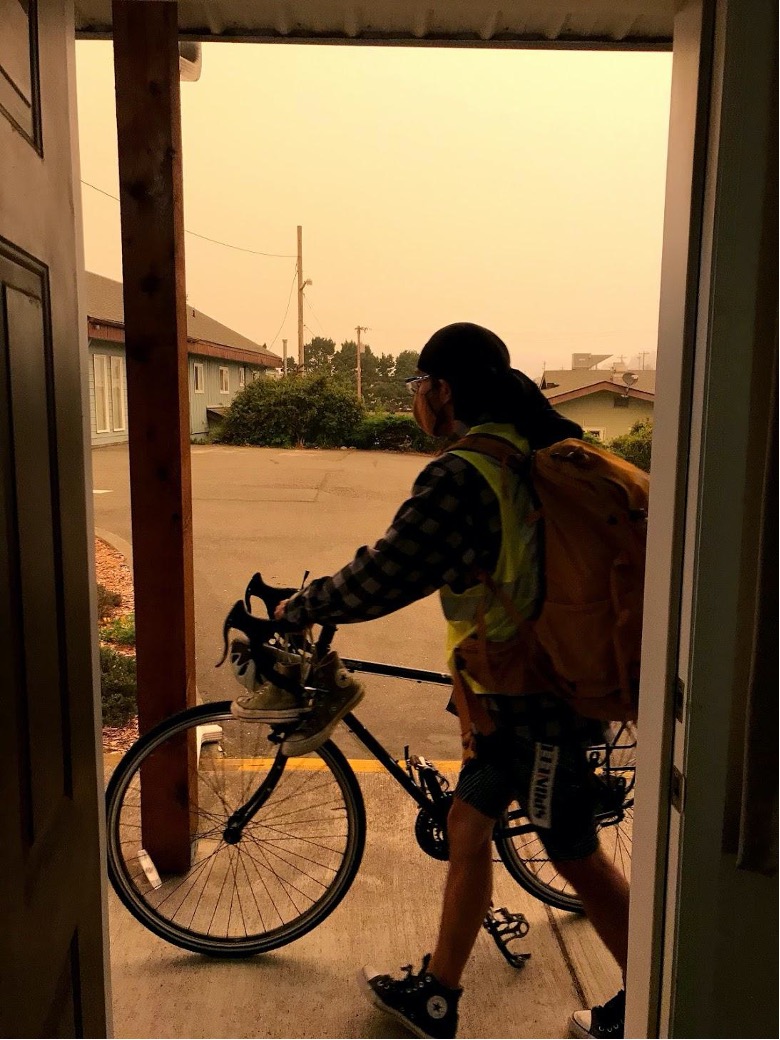Join us in this three-part series as we bike 800 miles down Oregon and California, exploring the impacts of COVID and climate change in coastal communities. This series focuses on stories of people, place, and change.
We just wanted to sleep in. But when we woke up, our legs sore from the previous day’s 43 miles, the eerie orange light streaming through the window caught our eyes. Something wasn’t right.
We pulled on our sweatshirts, our sockless shoes.
And when we stepped outside, the sky was an apocalyptic yellow. Something about all the smoke made the air seem thick–like we could swim through it, like we could touch it and feel it.
The fires had erupted seemingly overnight. Dry conditions and high winds created a nightmare situation that would ultimately lead to 1,000,000 scorched acres and 40,000 evacuees in Oregon in that week alone.
Flecks of ash began to gather on my shoulders. I saw headlights shine dimly through the smoke. A truck heavy with timber rumbled by–slow, like it was driving through fog or rain–and disappeared at the end of the block.
“What do you think?”
I didn’t know what to say. It couldn’t be healthy to ride our bikes in this, it couldn’t be healthy to breathe this in.
But the fires hadn’t overtaken our route yet. And the longer we stayed here, the worse it might get.

I used to think of climate change as something that affected other places.
Rising sea levels would get to Florida and Louisiana and the Pacific Islands first. Hurricanes are a Gulf Coast problem, typhoons a problem in the Philippines. Drought and extreme heat would strike at the equator.
Growing up in California, fires were an ever-present danger, but the extreme cases only seemed to hit every five or ten years. Recently, it’s felt like every year is a bad one.
I’ve heard the argument that when climate change becomes a real issue, we’ll have the technology to solve it. We’ll grow plants in space. We’ll terraform Mars.
But climate change is here. And I wonder if we’re ready.
We decided to make the 28-mile ride. It felt like our best option was to keep moving.
At first, it didn’t seem so bad. We could breathe through the smoke as long as we took it easy.
We stopped at a cliffside viewpoint in the San Sebastian Scenic Corridor. Up there, the air felt a little thinner, the ocean view lost to the smoke.
We were exhausted when we finally rode into Brookings, our eyes scratchy, our throats dry. The ocean fog seemed to mix with the haze here, the smell of salt and burning wood filled our senses.
My head started pounding for the last few miles of the ride. I just wanted to get into warm clothes and get something to eat.
We were supposed to ride the next day, but the fires out east were mostly uncontained, and the dry and the wind persisted. We still had a decision to make, but we resolved to rest for now. And tomorrow, we thought, we’ll do what we can.

DISCUSSING “CLIMATE CHANGE ADAPTATION” IN THE CLASSROOM:
Human Geography is about understanding our place in the world. Different physical, geological, and cultural elements affect how we live, and how we adapt to our surroundings.
Climate change will affect different parts of the world in different ways. As the earth’s climate changes, what might this mean for the region you live in?
- Create a map of your school, town, or region. Outline what areas are prone to climate change. Consider things like water supply, public health, and agriculture, as well as natural factors.
- Create your own climate adaptability plan.
- • What effects do you think climate change will have on your region?
- • Create an infographic or step-by-step plan on how you would deal with these changes.
- Find your city or region’s climate adaptability plan.
- • Based upon the plan, what effects might climate change have on your region?
- • Are there any environmental concerns you have that the plan doesn’t address?
The Samples You Want Without The Wait!
Copyright 2017 | National Geographic Learning Product News and Resources | AP® is a trademark registered and/or owned by the College Board, which was not involved in the production of, and does not endorse, this product. | “National Geographic”, “National Geographic Society” and the “Yellow Border Design” are registered trademarks of the National Geographic Society ®Marcas Registradas.
